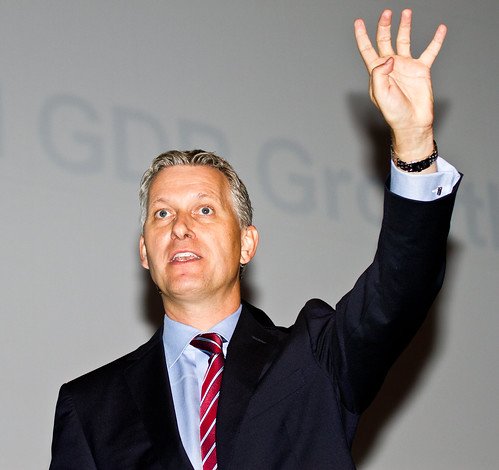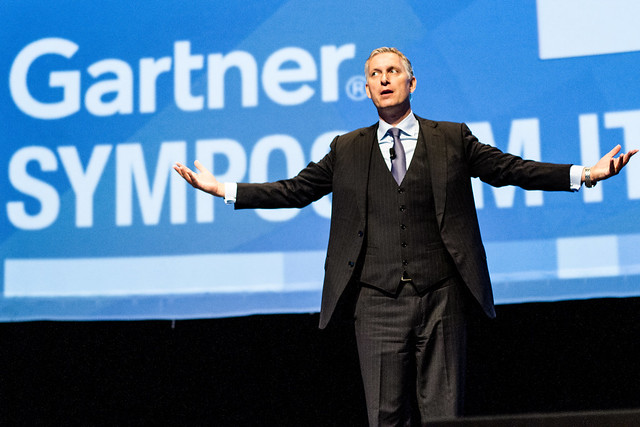 The Nexus of Forces – cloud, mobile, big data and social media – have come together and, as expected, caused major disruption in the IT industry. But the disruption doesn’t stop in the IT department: the technology landscape has made it necessary for whole companies to transform themselves into digital enterprises.
The Nexus of Forces – cloud, mobile, big data and social media – have come together and, as expected, caused major disruption in the IT industry. But the disruption doesn’t stop in the IT department: the technology landscape has made it necessary for whole companies to transform themselves into digital enterprises.
This was the overarching message at this year’s Gartner Symposium in Cape Town, where the research company outlined how CIOs can help to guide their organisations into the new world.
Kathy Gibson reports.
 Mobile, cloud, social and information has reshaped IT forever, and this nexus of forces has given rise to the digital business.
Mobile, cloud, social and information has reshaped IT forever, and this nexus of forces has given rise to the digital business.
This is where the virtual and physical worlds come together via the Internet of Things (IoT), says Peter Søndergaard, senior vice-president: research at Gartner.
Not only is the digital business redefining IT and the markets, but it’s also having a profound effect on human beings. “It affects your job, it affects your workforce and it affects your entire future,” he says. “Make no mistake, digital business is becoming a reality, and is merging the virtual and the physical world together.”
As a result, Søndergaard says, we are experiencing the establishment of digital processes and business models leading to the realisation of the digital business moment both in commercial enterprises and the public sector.
“Every company is truly a technology company, and digital business changes both IT leadership and the IT market itself.”
People are changing too, he says. “Today, people spend more time in the digital world than they spend sleeping – you could call that digital first. Customers will engage with your products in the digital world long before they engage you physically. So the customer experience fundamentally changes in the digital business.”
Søndergaard points out that while companies now have digital customers, they also have digital employees. “The typical person carries several devices at all times. The typical employee twice as many,” he says. “Remember that your digital employees are digital customers as well and they want to use what they use at home. So put the systems in place to connect digital employees with digital customers – let them choose their modes of collaboration, then get out of the way.”
In the new digital industrial economy, the CIO’s job and his relationships with the rest of the business are changing.
“Fluid change is swirling all around you,” Søndergaard says.
This raises the big question that bothers IT leaders: who is in control of this new environment?
IT spending around the world is set for slow growth, at just 2,1%. While Europe will be flat, Africa is expecting 5,4% growth in 2014.
Rather more interesting is the fact that the global IT services market will hit $1-trillion this year – and the really interesting information is that half of that figure will be spent outside of the IT organisation.
“Today, 38% of IT spend is outside the IT organisation already and, in South Africa, it is already 48%,” Søndergaard says.
Driving this spend is a rapid decrease in the cost of cloud services and more fluid pricing. “By 2018, businesses will only own half of the world’s server computing capacity. Integrated systems that are purchased as a bundle will already count for 28% of spending next year.”
With the growth of the IoT, he believes the CIO needs to get back in control as security and manageability will be more important than ever. “A typical business will have 1-million IP addresses to manage by 2018,” he warns.
As the digital business model takes off, Songergaard says that IT organisations need to start acting more like the business units within their own companies – and these business units, which are spending 28% of IT budgets today, are increasingly starting to look like technology start-ups.
“To do this, you have to do three things: re-invent your IT budget through new technologies, thinking and acting like a start-up; refocus the priorities of the IT organisation and the CIO’s role; and reskill the IT organisation and play the advisor of the technology reskilling of the entire organisation.”
Your industry is at risk, too
So far, the industries that have been most disrupted by digitalisation has been those without a physical product: music, consulting, media – but we are now seeing massive new disruptions as even physical products are being digitalised and more traditional companies than ever before are impacted.
 Gartner analyst Mark Raskino says this change is being driven by a number of factors:
Gartner analyst Mark Raskino says this change is being driven by a number of factors:
* The great financial crisis is receding into history and business leaders are under pressure to find growth;
* Investment capital has been piling up and that money must be put to work – and returned to shareholders;
* The great BRICS growth story is slowing and strategists are seeking other vectors for growth, which digital can provide;
* The disruptive potential of multiple technologies has been backing up, unleveraged, for years – so technology is running ahead of corporates’ ability to use it; and
* One near death corporate example more than any other has caused boardrooms to rethink.
“Kodak virtually invented digital cameras and was still disrupted,” Raskino says. “Boards saying that if it could happen to Kodak, it might happen to them – and Kodak was effectively operating in a physical industry.”
The Internet has had a profound impact on the way many businesses are run, he adds. Most companies had a Web site by 1996 and some e-commerce capability by 1997. On the supply side of our companies, it’s given us CRM and digital media; on the buy side, we’ve got supply chain management and e-procurement. Stakeholders now have investor or media resource while inside the company we started with intranets, turned them into portals and now call them collaboration.
“In fact, the Internet has had an effect on everything in the company except for the bit in the middle – our core competency,” Raskino says. “The one thing we haven’t changed is the product, although we changed everything around the product.
“Now, we are going to remaster the products. We are going to re-render our products and their value in a digital format. We can do this by re-imagining and re-rendering existing products and services using today’s technology; or by redefining what mastery of an industry looks like and which firms are new masters.”
Because the competencies required to build the products of yesterday and the products of today are different, there’s no guarantee who will end up as the master of this new world – it may be the current industry leaders and it may not.
Raskino points out that, while we can see technology redefining everyone else’s products, it’s hard to imagine it happening to our own.
“We saw it happening to music and then to books,” he says. “But the book people didn’t see it coming, despite the example from the music industry, because it was felt that books were inherently physical. Today, 40% of fiction books are downloads – and the e-reader only came out in 2007.”
Other physical products that are being replaced by new, digital products include cameras, which are not only being digitalised but placed into other form factors.
Even cars are moving to digitalisation, with new electronic features becoming as important as engine performance. 3D is enabling jewellery that can be uniquely crafted, in shapes that cannot be produced in any other way.
Even a lawnmower can be digitised, Raskino says, pointing to a robotic mower that is especially designed to care for golf courses.
Other examples of rapid digitisation of physical products include education, fighting machines and even money or water, which can now be analysed as it’s used. “Even pizza is being digitalised, with the delivery portion of the purchase now being serviced by drones,” Raskino says.
“Even cigarettes are going electronic, which shows that any product can be re-imagined by electro-digitalising it.” The tobacco companies have learnt from the example of the book printers and have bought into the e-cigarette movement – and its anticipated they will generate more revenue from e-cigarettes that by tobacco-burning cigarettes within just 10 years.
In the new world of digitalisation, a company’s traditional competitors won’t be where the threats will come from. “The attack will come from the side and from underneath,” says Raskino. “But your company will come under threat, because companies like yours are already under threat.”
The digital giants like Google, Amazon and Apple are threatening every industry. “They are good at it, they believe in the future of information, and they believe that your product must be digitalised,” Raskino says. “It wasn’t Ford or BMW that invented the self-driving car – it was Google. The big digital new-age companies could dictate the future of the industries they are interested in. But the disruption could also come from start-ups.
“Attackers will use digital forces to enter your industry by dissolving traditional industry boundaries. As a result, some new-age companies won’t even know what industry they play in.”
The new world of digitalisation is a cut-throat business, Raskino says. “Winner takes all – whoever controls the platform will win the game.”
He suggest companies start to reinvent their own businesses and remaster their own products, and offers some recommendations:
* Your need to get the strategic digital business innovation conversation going at board level;
* Digital must be an important part of the business strategy;
* Ensure core product innovation is included in the digital strategy – not just how it is sold;
* Fund digital business seriously; and
* Talk to your competitors – that’s not where the threat is going to come from.
